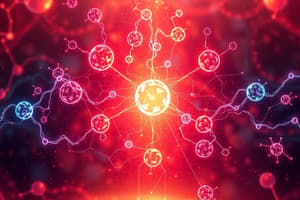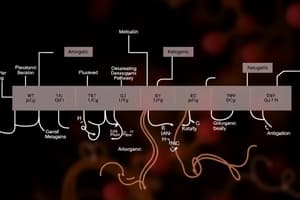Podcast
Questions and Answers
What is the role of non-protein amino acids in metabolic processes?
What is the role of non-protein amino acids in metabolic processes?
- They are involved in the synthesis of nucleic acids
- They are involved in the regulation of gene expression
- They are involved in the biosynthesis of neurotransmitters (correct)
- They are involved in the breakdown of carbohydrates
What is the chemical process in which a molecule is cleaved into two parts by the addition of a water molecule?
What is the chemical process in which a molecule is cleaved into two parts by the addition of a water molecule?
- Hydrolysis (correct)
- Decarboxylation
- Phosphorolysis
- Transamination
What is the primary function of the Krebs cycle?
What is the primary function of the Krebs cycle?
- To convert carbohydrates, fats, and proteins into energy (correct)
- To generate ATP during glycolysis
- To regulate gene expression in cells
- To synthesize glycogen in animal cells
What is the primary function of glycogen in animal cells?
What is the primary function of glycogen in animal cells?
What is the outcome of the galactose metabolism pathway?
What is the outcome of the galactose metabolism pathway?
What is the net outcome of the glycolysis pathway?
What is the net outcome of the glycolysis pathway?
What is the characteristic of the hydrocarbon chain in a fatty acid?
What is the characteristic of the hydrocarbon chain in a fatty acid?
What is the type of bond that connects sugar units in carbohydrates?
What is the type of bond that connects sugar units in carbohydrates?
What is the main constituent of vegetable oil and animal fats?
What is the main constituent of vegetable oil and animal fats?
What is the side chain that varies between different amino acids?
What is the side chain that varies between different amino acids?
What is the function of phospholipids in cells?
What is the function of phospholipids in cells?
What is the fate of some amino acids in the cell?
What is the fate of some amino acids in the cell?
What is the primary characteristic of multidisciplinary input in biotechnology?
What is the primary characteristic of multidisciplinary input in biotechnology?
What are the three main areas of applied science in biotechnology?
What are the three main areas of applied science in biotechnology?
Which of the following is NOT a multidisciplinary input in biotechnology?
Which of the following is NOT a multidisciplinary input in biotechnology?
What is the study of the chemical substances and vital processes occurring in living organisms?
What is the study of the chemical substances and vital processes occurring in living organisms?
What type of groups are attracted to the charges within water and can form hydrogen bonds with water?
What type of groups are attracted to the charges within water and can form hydrogen bonds with water?
What is a characteristic of living organisms?
What is a characteristic of living organisms?
Flashcards are hidden until you start studying
Study Notes
Non-Protein Amino Acids
- Involved as metabolic intermediates, such as in the biosynthesis of the neurotransmitter gamma-aminobutyric acid.
Nucleic Acids
- Composed of nucleotides.
Major Types of Biochemical Reactions
- Oxidation: loss of electrons.
- Reduction: gain of electrons.
- Hydrolysis: chemical process in which a molecule is cleaved into two parts by the addition of a water molecule.
- Phosphorolysis: splitting of a bond by the addition of phosphoric acid to a compound.
- Decarboxylation: loss of carbon dioxide.
- Deamination: removal of amino group.
- Transamination: transfer of amino group from one molecule to another.
Metabolic Pathways of Biochemistry
- Carbohydrate Metabolism:
- Glycolysis
- Krebs Cycle
- Glycogen Biosynthesis
- Galactose Pathway
- Calvin Cycle
Glycolysis
- Metabolic pathway that converts glucose to pyruvate, releasing free energy in the form of ATP and NADH.
Krebs Cycle
- Metabolic pathway involved in the chemical conversion of carbohydrates, fats, and proteins into carbon dioxide and water to generate energy.
Glycogen Biosynthesis
- Glycogen is a polysaccharide that functions as the secondary long-term and mobile energy storage in animal and fungal cells.
Galactose Metabolism
- The conversion of galactose into glucose, lactose, and other sugar intermediates.
Modern Biotechnology: Multidisciplinary Input
- Biotechnology is multidisciplinary, involving a number of disciplines that are coordinated for a desired outcome.
- Areas of science involved:
- Life sciences
- Physical sciences and mathematics
- Social sciences
- Applied sciences
- Areas of applied science involved:
- Computer applications
- Engineering
- Agriculture
Biochemistry
- The study of the chemical substances and vital processes occurring in living organisms.
- Biochemical pathways, enzymes, and macromolecules are involved.
Living Organisms
- Able to transform matter and energy into different forms, show response to changes in their environment, and show growth and reproduction.
- All living organisms undergo changes due to large organic compounds called macromolecules.
Hydrophobic, Hydrophilic, and Amphipathic Groups
- Hydrophobic groups: cannot form hydrogen bonds with water (e.g., hydrocarbons).
- Hydrophilic groups: are attracted to the charges within water and can form hydrogen bonds with water.
- Amphipathic groups: have both polar and non-polar groups (e.g., hydrocarbon chain is non-polar and carboxyl group is polar).
Biochemical Compounds (Macromolecules)
- There are four main classes of macromolecules:
- Carbohydrates
- Lipids
- Proteins
- Nucleic acids
Carbohydrates
- Sugar units are connected together by glycosidic bonds.
Lipids
- Insoluble in water but soluble in organic solvents.
- Classes of lipids:
- Fatty acids: carboxylic acids with long hydrocarbon chains.
- Triglycerides: an ester derived from glycerol and three fatty acids.
- Phospholipids: major component of cell membranes that form lipid bilayers.
- Steroids: organic compounds that can be found in all organisms.
Proteins
- Amino acids are the structural units that make up proteins.
Amino Acids
- Molecules containing an amine group, a carboxylic acid group, and a side chain that varies between different amino acids.
- Many amino acids are used to synthesize other molecules, such as:
- Tryptophan: precursor of the neurotransmitter serotonin.
- Glycine: precursor of porphyrins such as heme.
- Arginine: precursor of nitric oxide.
- Aspartate, glycine, and glutamine: precursors of nucleotides.
Studying That Suits You
Use AI to generate personalized quizzes and flashcards to suit your learning preferences.




